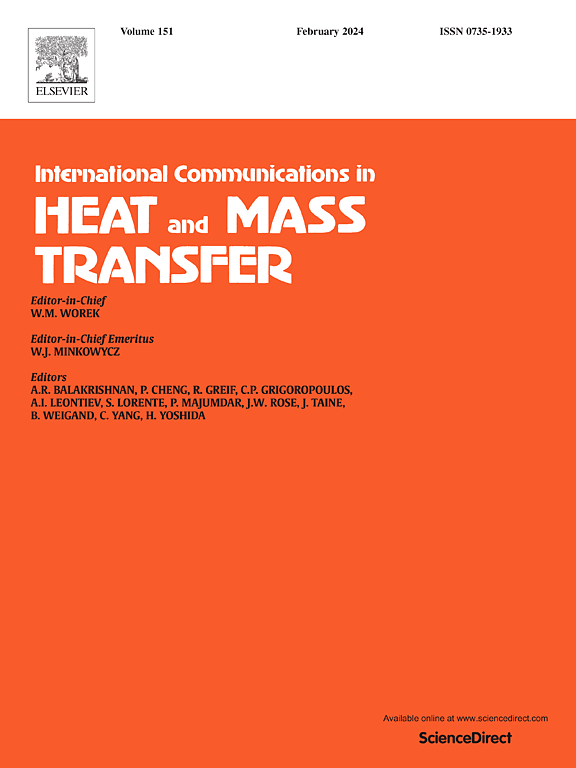基于混合晶格玻尔兹曼模型的电流体动力结晶各向异性凝固
IF 6.4
2区 工程技术
Q1 MECHANICS
International Communications in Heat and Mass Transfer
Pub Date : 2025-05-14
DOI:10.1016/j.icheatmasstransfer.2025.109059
引用次数: 0
摘要
电流体力学是控制凝固过程的有效方法。虽然大多数研究都集中在各向同性凝固上,但晶体各向异性对电流体动力学凝固的影响尚未得到充分的研究。本研究采用基于混合晶格玻尔兹曼方法的数值模拟,研究了不同电场强度和物理性质对电流体动力结晶各向异性凝固的影响,重点研究了枝晶生长速率和固液界面形貌。研究发现,大的电瑞利数增强了流动运动,锐化了上游浓度梯度,促进了额支生长,抑制了侧向生长。材料性能,包括扩散系数比和离子迁移率比,通过改变电荷输运显著影响局部固液界面形貌。低扩散系数比导致多个涡,高扩散系数比导致更简单的流动结构。离子迁移率控制界面电荷梯度。当固相离子迁移率高于液相时,界面电荷积累引起流动运动,触发Mullins-Sekerka不稳定性。在定向凝固中,离子迁移率影响界面Mullins-Sekerka不稳定性的发生,而电强度则增强枝晶尖端之间的竞争。这些结果为电流体力学在材料制造智能控制中的应用提供了一条途径。本文章由计算机程序翻译,如有差异,请以英文原文为准。
Electrohydrodynamic crystalline anisotropic solidification based on a hybrid lattice Boltzmann model
Electrohydrodynamics is an efficient approach to control the solidification process. While most studies focus on isotropic solidification, the effects of crystalline anisotropy on Electrohydrodynamics solidification remain unexplored. This study uses numerical simulations based on a hybrid lattice Boltzmann method to examine the effects of varying electric field strengths and physical properties on electrohydrodynamic crystalline anisotropic solidification, focusing on dendrite growth rate and solid-liquid interface morphology. It is found that large electrical Rayleigh numbers enhance flow motion, sharpening the upstream concentration gradient, and promoting frontal branch growth while suppressing lateral growth. Material properties, including the diffusion coefficient ratio and ionic mobility ratio, significantly affect the local solid-liquid interface morphology by modifying electric charge transport. Low diffusion coefficient ratios lead to multiple vortices, while higher ones result in simpler flow structures. Ionic mobility ratio controls the interfacial charge gradient. When the solid phase exhibits higher ionic mobility than the liquid, interfacial charge accumulation induces flow motion, triggering the Mullins-Sekerka instability. In directional solidification, the ionic mobility ratio influences the onset of the interface Mullins-Sekerka instability, while the electric strength enhances competition among dendritic tips. These results provide an avenue for the application of electrohydrodynamics in the smart control of material manufacture.
求助全文
通过发布文献求助,成功后即可免费获取论文全文。
去求助
来源期刊
CiteScore
11.00
自引率
10.00%
发文量
648
审稿时长
32 days
期刊介绍:
International Communications in Heat and Mass Transfer serves as a world forum for the rapid dissemination of new ideas, new measurement techniques, preliminary findings of ongoing investigations, discussions, and criticisms in the field of heat and mass transfer. Two types of manuscript will be considered for publication: communications (short reports of new work or discussions of work which has already been published) and summaries (abstracts of reports, theses or manuscripts which are too long for publication in full). Together with its companion publication, International Journal of Heat and Mass Transfer, with which it shares the same Board of Editors, this journal is read by research workers and engineers throughout the world.

 求助内容:
求助内容: 应助结果提醒方式:
应助结果提醒方式:


